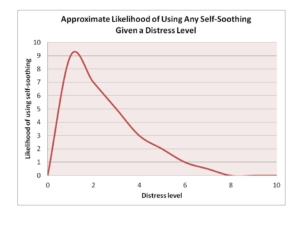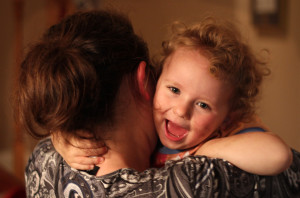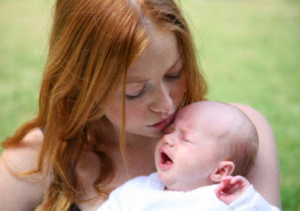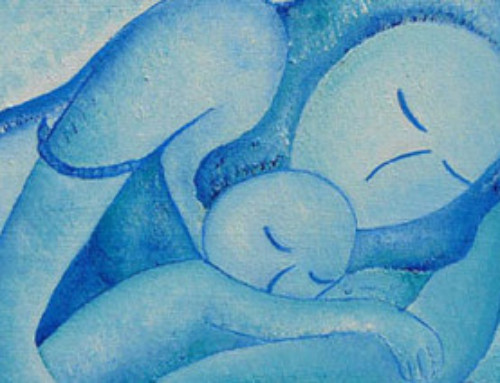Some of you aren’t there yet, some of you are in the midst of this, and some have come through the other side with a whole new set of skills and experiences: That moment when your child refuses your comfort when they are upset. That moment they are upset and instead of coming towards you, they are getting away. To be clear, this isn’t about infants, for if they are arching away when upset they are likely picking up on your distress or are in pain and trying to move around to relieve it. No, this is about your toddler or perhaps preschooler.
The child who would get upset, frustrated, angry, or hurt and would cuddle in your arms until the feeling passed. You could feel like you could ease all the hurt in the world so long as he could just snuggle in while you held him tight and stroked his hair or face or just simply sat with him. No longer. Suddenly you find yourself reaching for your child in his moment of upset and instead of turning towards you, he turns away. In that moment, you feel the air leave the room and the panic set in.
What have I done? Does he not feel attached to me anymore? Have I not been there enough lately?
But she refuses.
***
Too many parents find themselves in this situation. They feel helpless and as if they have done something “wrong” with their child. What is missing from the discussion, and why this discussion is based solely with toddlers and up and not younger children, is that this is very normal and actually quite healthy. Not all children will do this (after all, outside of normal bodily functions, there’s almost nothing universal about how children express themselves), so don’t panic if your child doesn’t, but for those going through this stage, it’s essential to better understand it and how to cope.
What is going on?
In short, your child is trying out self-soothing. We’ve been so misled to believe that children master this skill early in infancy that we ignore that that is a far cry from what is biologically normal or even possible. The first real stage of emotion regulation that infants’ show is seeking out a caregiver for assistance in their ability to soothe themselves (see here for a review), but as they develop, they learn new skills that help them self-soothe. Of course, to see how these work, a child needs to practice them. Without practice, he doesn’t know how it will work or even if it will work.
What age does this start?
 The age will be highly variable depending on a variety of factors. Of course child temperament will be a huge factor, with many highly sensitive children likely demonstrating this later than their less sensitive peers. Research on children who are highly sensitive shows that they seem to require much more responsive parenting in order to thrive (see here) and this can include longer bouts of needing the modeling of responsiveness before they can attempt to self-soothe on their own.
The age will be highly variable depending on a variety of factors. Of course child temperament will be a huge factor, with many highly sensitive children likely demonstrating this later than their less sensitive peers. Research on children who are highly sensitive shows that they seem to require much more responsive parenting in order to thrive (see here) and this can include longer bouts of needing the modeling of responsiveness before they can attempt to self-soothe on their own.
Other factors that may influence when this change occurs include: the amount of time spent away from the attached caregiver, such as when a child enters a daycare or preschool environment, as she realizes that she needs to have certain skills for when that comforting person is not physically present to help; the individual child’s degree of reactivity as greater distress will inhibit the ability and effort to self-soothe as this can only start to happen at lower levels of distress; presence of older siblings, as older siblings often model things for their younger siblings unintentionally and so younger siblings have often had more modeling experience than older siblings; and more.
How can I best respond?
Sometimes the frustration a parent feels in these moments overrides everything. Feeling hurt and hopeless can lead to anger and resentment or simply giving up, yet none of these responses actually help our children in this moment (or you, the parent, for that matter). Hopefully when we can realize that our child is attempting a new skill – like tying a shoe or getting dressed on one’s own – we can approach it with the same level-headedness and responsiveness that we would these other developing skills.
This means that we need to focus on being present without being pushy and being ready to offer comfort when or if it is needed. Giving our child their space to try and self-soothe is essential, but letting him know that we are here if needed is equally essential. If we walk away from him in a huff, we simply add to his distress, lowering the likelihood of him being able to self-soothe, but also taking away the safe place he has grown to know and rely upon. If we jump in and try to force him to take our comfort instead of trying on his own to calm, then we are telling him that he is incapable of this task, lowering his self-esteem and sense of trust in himself as to when to try new things.
The middle ground is simply being there. I often recommend to people to let their child know you’re there verbally and to be in a spot where she can see you if needs be. It may mean putting whatever you were doing or going to do on hold for a while as you sit by and wait for her to come to you, but this is part of what helping our children develop their independence – and in this case, self-soothing – looks like. You may end up waiting 2 minutes, it may be 30, but being there and ready is essential.
What happens after?
This will likely depend on the degree of success that your child has had in self-soothing. If your child couldn’t soothe and had to come to you, you should first and foremost focus on the act of soothing and comforting. Once she is calm, it is important that you acknowledge her efforts in self-soothing in a positive way and let her know that sometimes it is hard to calm down on our own and that you’ll always be there when that’s the case. If your child was successful, she will still likely come to you after. This is the moment you can acknowledge her efforts and success while still letting her know that you’re always there if sometimes she needs a little help calming down.
How do I talk to my kids about their efforts?
Sometimes our issue as parents is how to talk about these high-level concepts with kids in a way they understand. Talking about “self-soothing” or “emotion regulation” is clearly not the way to talk about it. Some families find success talking about having some time alone to calm down or just because one wants some time alone. Some families find success talking about having one’s own space, or special space, to go to when one needs it. However you discuss it with your child, you just need to make sure it’s in words and using constructs that he will understand and that you can incorporate into your daily lives. This incorporation will make it easier for him to think of his efforts first when in mild-moderate distress and being aware of how others use their own private time or space to calm down too. Modeling our self-soothing is often even more effective than simply discussing it with our kids.
Of course, as mentioned above, one of the critical elements of discussion is finding the fine line of acknowledging and supporting their efforts while making it clear that you are there when necessary.  Parents can get too caught up in over-praising the effort which can make the child feel as though they have to do this self-soothing thing each and every time, even when they may not be ready. Obviously no one wants that.
Parents can get too caught up in over-praising the effort which can make the child feel as though they have to do this self-soothing thing each and every time, even when they may not be ready. Obviously no one wants that.
Remember: Emotion regulation is an ongoing process that our children will be learning for years. It starts with simply seeking us out and then eventually trying some skills on their own, but even us adults need help now and again. Expecting too much or too little will only pose problems in the long-run. Follow your children’s lead and know that they will get there in their own time.
An important note: This type of self-soothing practice can also be reflective of the following:
- Sensory issues. Children who struggle with sensory overload may seek to run away to remove the stimulation.
- Developmental differences. Other developmental differences, such as Autism Spectrum Disorders, can also present with these behaviours.
- Insecure attachment. Insecure attachment can manifest in a child being resistant to comfort, starting in infancy and continuing on into the toddler and preschool years.
Unfortunately we may not know the entire reasons for why our children are this way, but know that if you are a responsive, caring parent, #3 is unlikely to be the reason. [/fusion_builder_column][/fusion_builder_row][/fusion_builder_container]







[…] helpful. And then, as if she knew what was going on, Evolutionary Parenting wrote a post about toddlers refusing comfort. Although she doesn’t specifically talk about nursing strikes, her post reminded me that we […]
Thank you Tracy, this is very helpful!
I’m glad 🙂
Interesting post. Although I am always very wary of this y first question on any research done on “highly sensitive” toddlers and/or children is at what age; for what reason and under which circumstances were they weaned from the breast. The children studied are always those who had been prematurely weaned so I find any results and conclusions made highly problematic to interpret.
For example in this case, if the child in question could not be comforted by their (biological) mother (provided she was also the primary care-giver) in times of distress, I would hypothesise that there could be other (more likely) reasons for this behaviour, such as weaning trauma. This type of early and mostly nonverbal trauma is often accompanied by sleep separation (end or dramatic decrease of bed sharing); increasing maternal separation combined with bonding with an unknown caregiver (spending more time in non familial/professional care) and significant change in the family structure and dynamics (such as the birth of a new sibling) and would correlate with the mother’s (in my example) feelings of hurt and hopelessness (or what I would describe as rejection) much more clearly than a child learning the “skill” (which I would personally descirbe as a coping mechanism) of self soothing.
To answer your questions:
1) Most research on highly sensitive children has the sensitive child defined in infancy with outcomes later.
2) With respect to your hypothesis, that may be the case in some cases but I can say that many cases that’s not often the case. Using my daughter as an example, she’s five, we still bedshare, she nurses, I’m home, etc and she went through this stage. Now she often explains she wants a moment to herself first to process what’s going on then we cuddle. So it’s not about a parent not being able to comfort but comforting the child in a way that works for the child! Hope that helps.
Thank you for swift the reply and apologies for the typos/errors, why is it you only see them AFTER you press send?! 🙂
While I am not surprised that the term highly sensitive is defined in infancy when it can only be observed and interpreted through an adult lens, I think it provides further evidence that there are other more confounding factors contributing infant sensitivity, one of the most common being premature weaning but by no means the only factor at play. (I have listed more in my comment on your post on “stress-release” crying.)
In terms of your personal example, in times of distress does your daughter ask to feed (if not what age did she stop?) or refuse your offer to breastfeed (if you do offer…. Do you offer? If so at every upset or dependent on the situation?) or does she request a moment to herself process her emotions first without mention of and above the suggestion of comfort at the breast?
This is one area I would love to see more research based on interviews with both children directly and their mothers but sadly so few child here in the West have breastfeeding as an available comfort option.
My almost 2 year old is definitely sensitive. She meets the definitions for sensitive, high-need, spirited, etc. She isn’t weaned, still bed shares, and doesn’t attend daycare. When she’s angry she does refuse to nurse if offered and often runs away from us. She started doing that probably around 18 months. She needs space to be angry and will eventually come back. Trying to force her to stay with someone is more of a disaster than the total meltdown that’s already happening. My experience has been that people who doubt the existence of sensitive or high-needs kids have never met one.
Thank you for this article and for these comments! My little girl is 20 months and this behavior started 2 months ago. She is definitely a sensitive child and fits all of the criteria including being extremely active in the womb. My midwife actually wrote “wild fetal movements” in my charts. We co-sleep, babywear, and still nurse. When she is upset she will not nurse when offered and will not allow either parent to console her. This article makes perfect sense because this change coincides with her getting really focused on doing more adult things (buckling her shoes, folding clothes, feeding the dogs, etc.) and insisting on doing them on her own.
Hi Kate,
I wanted to reply to your response of my comment. Contrary to your experience, sadly I have certainly “met” a few sensitive or high-needs kids both personally (my own close large and extended family) and professionally (in multiple Western countries’ preschool settings) and it is due to those interaction that led me to research the possible (or more accurately currently know/studied/understood) reasons for the differences between them and children surrounding them and those outside of their cultural (non Western or W.I.E.R.D countries) and time (anthropological studied tribes) context.
Below is a list copy/pasted from my comment on another Evolutionary Parenting post entitled ‘ “Stress-release” Crying ‘ (that you may want to read for further context of the bases of my argument here). The list consists of *some* of the causes of distress and discomfort a child may experience and conversely offers an array of solutions or other methods to comfort the child in that particular situation.
The really tragic thing is – there are so many reasons that babies cry unbeknownst to even natural and “attachment” parents, the most notable but rarely stated being:
birth and or early postnatal trauma;
disrupted or unnaturally seeded microbiome;
mother incorrectly supported (postnatal visitors caring for baby while the mother cares for herself – or the notion self-care as opposed to being cared for/mother-roasting) or completely neglected/isolated;
undetected and thus untreated misalignment developed in-uteri and exasperated with continuous use of baby containers (car seats, swings, rockers and bouncers);
undetected and thus untreated oral (and often other body) restriction in function (tongue and lip tie);
male infant genital mutilation (circumcision);
undetected and thus untreated normally occurring vaccine related inflammation and injury;
having a wearable-toilet (cloth or plastic nappy/diaper) tightly wrapped around a baby’s delicate skin for practically 24 hours every single day;
being forced to use said wearable toilet due to the caregiver being unaware and too distracted to aid them in eliminating hygienically;
limited skin-to-skin contact due to the above and constant clothing;
little or no time spent being carried or worn in nature;
frequent and increasing maternal separation;
cultural rather than ecological breastfeeding patterns;
having less than 3 constant and consistent adult caregivers to 1 infant (specifically two additional experienced caregivers caring for them and their mother in addition to the
continuous care of their biological mother/ true allo-parenting)
While I know that this list is difficult to discuss, let alone practice in our culture, I do believe it is important to keep in mind when we struggle to mother our young. Many scientists and researchers have described babies (ALL babies) and maternal instincts as primal or even prehistoric in comparison to modern Western daily life. In many ways although these concepts are almost incompatible they do provide answers to seemingly improbable questions (why would an uncomfortable child not allow their primary and biological comforter to soothe them?) and statements such as “My Child Won’t Let Me Comfort!” and (I hope) grace to mothers and primary caregivers asking for help with these struggles.
I needed this… it has been going on a while. I have been reacting like a child myself. I knew this. My feelings were hurt at being shunned and i have genuinely “huffed off”… this has helped me understand somewhat…
Don’t worry – I think we’ve all been there 🙂 Just remember, your child is learning how to be independent and trying to soothe herself. She still needs and loves you, but it’s a difficult time this!!
Having just read this it does make sense to a certain extent but what if you as the mother are completely rejected ie crying is made worse, frowning and running away to a corner until daddy comes along and all is good with the world. Would be interested to learn how I should deal with that situation as it’s quite frankly ? xx
I would try to talk to your child when s/he is calm and find out why daddy is comforting and you are not. See how your little one can communicate with you. It may be that s/he feels the upset starts with you – something you’re doing (right or wrong) and this makes it difficult to accept help from you.
Thank you tracy! We have had this a few times in the night and my husband usually comes in and talks calmly and softly and makes me just lie on the bed. Now I understand why it works.
It goes against all my mummy instincts to not comfort my screaming toddler, and it’s devastating to see him cower away from me. So glad I found your article!
Your article is an interesting theory, but I don’t know if it’s really true in many situations. In my case and I think in many cases, a toddler tends to prefer one parent over another for soothing. When one parent is preferred, often, the toddler will cry until their preferred soothing parent comes at which point, they calm down almost immediately.
I have one child that I am preferred as the dad and main soother and another where the mom is preferred. Most times, my daughter will prefer mom for soothing and my son for me. There’s very little I can do to sooth my daughter when she’s in significant distress. She loves me deeply, but knows mom is the one she wants comfort from when distressed.
My observation is that most of the time, the child decides and there’s not much that can be done about it as a parent other than to be there and be supportive of the child. I’m ok with the situation with my daughter, but I can also see how it is very distressing to give so much to a child and not feel like they want your love or comfort.
My personal suggestion is to do more cuddling with your child. Cuddle when watching tv. Cuddle when putting them to bed. Cuddle when you are simply sitting together. Not just when they are distressed. Then, when they need it, they will be more open to it because they are used to it. The key is to do it when they are open to it. Like night time and tv time. Hope it helps and parents that have a child that won’t let you comfort them, don’t give up on them. They need your love.
This article made me cry and thank you. I’ve been reading your site for a while now, but have never seen this article – despite desperately needing it. I had even researched this and found a number of articles/questions/blog posts on this subject…we even went to a developmental pediatrician (who never mentioned self-soothing). Our daughter has done this, perhaps a half a dozen times, since she was just about 2.5 (she’s nearly 3) (most recently…yesterday). I’ve read the stuff about improper attachment and was devastated at the thought/possibility – we are completely devoted to our daughter and couldn’t understand how something like that would happen. These experiences have been extremely painful for us and I was sure (and still have some self-doubt) we were doing something wrong. The first time it happened, I didn’t know what was happening and probably made it worse – trying to encourage her to allow me to comfort her. Since then, we researched and read and employed acknowledging her feelings and offering support, when and if she needs it. This seems to only happen in connection with pickup from school. She really seems to love her school (it’s a pre-k – 8 Montessori school) and is really thriving there. Do you have any thoughts about this?
Thank you and I’m glad it helped 🙂
It’s hard to tell with just that. Could be just a build up of emotions at the end of the day that she needs to release. She may not need you to comfort but rather just to allow the space for her to have them.
Hi, I read your article and I’m a little confused. Especially at the very end where you basically said a child who’s always done that has a insecure attachment with caregiver. I wonder if you might be able to clarify this to me a little. My 22 month old daughter has done has ran away to the bedroom in a corner or small space since I can remember. She walked at 15 months and has done it since then. Even when she would just stumble or anything before walking she would sway or hands and comfort away. I stay at home with her, no one else has cares for her except an occasional stay with great grandma for 3-4 hrs, we bed share but I wasn’t able to breastfeed her. I am so hurt and confused as to why she acts like this. She gets quite upset and seemingly small things and takes off running to the bedroom, I used to follow her and try to comfort but I don’t anymore. I’ll let her run and she’s gone for 30 seconds and then she comes back out and carries in with whatever she was doing. Sometimes if I’m really concerned I will go and sit in the bed and give her space until she’s ready to come out. I feel like I’m doing something to cause this response. Ultimately I feel like maybe I’m not mothering her very well long story short I was raised by my dad and my mother lived 1,000 miles away. I always felt abandoned and obviously never experienced that nurturing form my mother so in return I feel like maybe I’m not nurturing her properly and exotically when she does this. Please, please help me find an answer or solution. I don’t m ow what to do. I don’t want her to have a emotion regulation problem, I feel like I have that and it’s very hard to work through. Maybe it’s hereditary but God I hope not.
I will check my wording for it definitely reflecting insecure attachment because that’s not the case and I don’t want people thinking that. It is a higher risk of insecure attachment, but can reflect sensory processing issues (too much contact overwhelms), Austism Spectrum Disorders, and other developmental differences.
Now if she’s only gone 30 seconds, it sounds more like she’s getting away from stimuli which could be reflective of some sensory issues (many kids have these not just those diagnosed with SPD) and so perhaps finding a safe quiet spot that’s just hers is what she needs from you too?
Thank you so much. I was starting to worry and wonder why my 18 month old wouldn’t let me comfort him when he is upset. He screams and runs away from me. I was starting to get really worried. He always come back for a cuddle. And he has recently started with a childminder, so this makes sense. I feel very reassured
I am trying my best to be a responsive mother, but my own childhood and youth have been turbulent, with war and losing my home when 10, witnessing domestic violence until my mother finally managed to get a divorce, ending up being a “black sheep” of the family (gifted child, lots of expectations, failed miserably), and then emotionally abused by mother (still present, and I have to take the kid to her place often for the time being, because I was on maternal leave until January and his father was self-employed but with no earnings 😒… He only recently started looking for a job, and I resent him for bringing us to this situation where we’re next to penniless and have to depend on my mother). She isn’t like that with my sister. Anyway, I have issues of my own as a result, including low levels of patience, self-control and tolerance to stress. I used to be highly sensitive and empathetic, and now I feel like all my empathy is gone and I struggle to figure out what my toddler boy needs when he’s crying. I lost patience a few times with him (when he’d kick me after I’d tell him repeatedly not to because it hurts), and I slapped him on the butt, which I instantly regretted.
I assume a lot of my nervousness has been “transferred” to him during pregnancy (yet another stressful period in my shitty life), and I complained to his father (we barely tolerate each other anymore, or at least I can’t tolerate an adult child in addition to a toddler and a reactive, anxious dog) that our son refuses my comforting… to which he commented that it’s most likely because he feels my anxiety/nervousness and it doesn’t help him calm down. It broke me down in tears, because I already feel like I’m a horrible mother, and this just added more salt onto the wound.
Just now I read an article saying that the toddlers can push parents away when crying because they’re practising the skill of self-soothing, and I don’t know if it’s wishful thinking for me, or could it really be the case? 😭